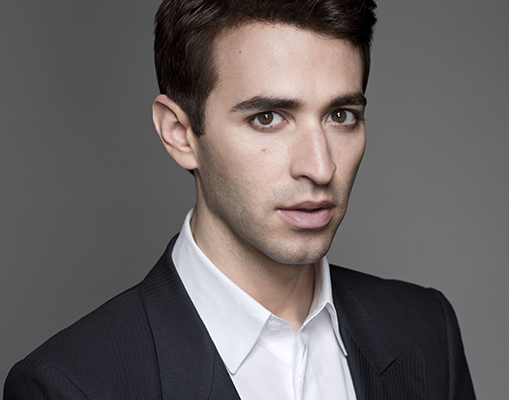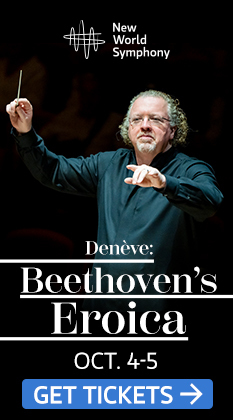From Gluck to Glass, Anthony Roth Costanzo is broadening opera’s reach

Countertenor Anthony Roth Costanzo will make his Florida Grand Opera debut in Gluck’s “Orfeo ed Euridice” Saturday night. Photo: Matthu Placek
“I hang out with people who go to galleries, who are in fashion; they go to the Gucci show and have ideas about how they [set] it to music—they are primed for the opera experience.”
Countertenor Anthony Roth Costanzo was sharing his ideas over the phone about opera, ways in which he can grow the genre’s popularity, and his upcoming performances as Orfeo in Florida Grand Opera’s production of Gluck’s Orfeo ed Euridice. Saturday’s opening night performance will mark Costanzo’s debut with FGO. Local favorite, soprano Eglise Gutiérrez, will be his costar as Euridice.
Costanzo will be spelled in the role of Orfeo March 18 and 23 by Lindsay Ammann (who will also be making her FGO debut in those performances). That a countertenor and a contralto can sing the same part in the same production is a window into the unique history of the opera.
Gluck’s original 1762 score (the one FGO is using) was written for a castrato in the alto range. Later versions, like the 1774 Paris one, were altered for different voice types–a French high tenor, for example. As the overall tuning of pitch rose through the 19th century, the opera became increasingly impractical to sing, leading to Berlioz’ 1859 transposition down for his friend, the contralto Pauline Viardot.
Orfeo “is one of my favorite roles to sing,” Costanzo said. “[He] is both strong and vulnerable, he’s a hero and also a complicated person.
“He’s not a good guy—he has so many qualities of the artist. He’s self-obsessed, but he’s also genuinely grieving. I like to layer him as someone who the audience likes, but also feels confused about.”
Costanzo hears all the material for the character coming straight out of Gluck’s score: “[It’s] interesting to see this complexity of a woman’s voice in a man’s body.
“[The] 1762 [version] is the most extreme of what Gluck was doing with his own work,” says the singer. “Gluck was looking back to Handel and looking to communicate with immediacy. There are moments to really sing [with] this gratifying fullness, and moments of Baroque stillness and clarity and vulnerability. So I like to find a lot of colors in my voice–from full-bodied red wines, to little wispy white ones.”
Costanzo has previously sung the role with Palm Beach Opera in 2011 (with the young Nadine Sierra who is now a star at the Met). Costanzo will be doing some of the music again in New York City in May, when he joins MasterVoices and the Orchestra of St. Luke’s for “Orphic Moments.” That program pairs a staging of Orfeo ed Euridice with the dramatic cantata The Orphic Moment, by Matthew Aucoin (May 6 and 7, in the Rose Theater, Jazz at Lincoln Center).
Orfeo and Gluck are something of a pivot point for Costanzo, a place that brings one back to Handel and then forward to Philip Glass. Singing the same character in music from Gluck and Aucoin means sharing a common formal and tonal view. Stepping from Gluck to Handel, and then forward to Glass, is a broader journey and one that Costanzo will take on his upcoming CD to be released later this year on the new Decca Gold label.
On the album, Costanzo will be singing Handel arias as well as vocal music from Glass. Glass sanctioned rescoring of his music for Les Violons du Roy, who accompany him in selections from Monsters of Grace, 1000 Airplanes on the Roof, Fall of the House of Usher, and Akhnaten.
“Handel is the proto-minimalist, like Wagner is the proto-cinematic composer,” Costanzo said. “You are extremely exposed, you have to use the best technique, he also uses the same text and repeats it in [different sections]. What this repetition does for the listener, is take them inward and forward dramatically.”
Costanzo’s own dramatic presence on stage, and his charisma and force as an actor, as well as a singer, will be a part of the new album. Although details are currently under wraps, there will be release performances in New York and at least one other East Coast city, These will include live installations with film, dance and live art making; joining Costanzo will be some of the foremost contemporary figures in filmmaking, choreography, and visual arts.
That will be one element in the singer’s ongoing drive to connect more people, especially younger people, to opera. Costanzo would like to accomplish this not by watering down the material, but by finding common ground in live performance and theatrical events, and showing how opera fits into all that.
Glass, of course, has a large contemporary following, a large percentage of which listens to his music but rarely reaches out into the larger (older) classical tradition. Costanzo has an affinity for the composer’s work, as well as the baroque and early classical periods. Early music and minimalism have long enjoyed an aesthetic companionship, and adding opera to this mix is something newer.
Glass is one of the most important opera composers of the last half-century as well as the most prolific. Costanzo will be taking on one of Glass’s greatest roles when he sings the lead of Akhnaten at the Metropolitan Opera House in 2019. The countertenor has already performed this staging in London and Los Angeles (directed by Phelim McDermott and designed by Julian Crouch of the British theater company Improbable).
Costanzo is excited about the possibility of new audiences being drawn in by the stage theatrics of this Akhnaten—especially the use of juggling, which was an ancient Egyptian art—and then captured by the gravity and beauty of the score.
Akhnaten is “quite an immersive experience,” he related. “I shave my head, and wax my body because I appear naked. I don’t go in for a lot of mumbo-jumbo, but [performing this role] does take me to a deeper place.”
Costanzo’s master plan is to take as many people as possible to that deeper place with him.
Florida Grand Opera’s Orfeo ed Euridice opens 7 p.m. Saturday at the Arsht Center in Miami and runs there through March 24, with two performances at the Broward Center in Fort Lauderdale March 29 and 31. fgo.org
Posted in Uncategorized
Leave a Comment
Mon Mar 12, 2018
at 4:11 pm
No Comments

